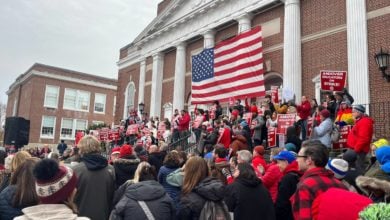Millions of people have poured into the streets in recent days to join courageous protests challenging the far-right government of Prime Minister Narendra Modi in India. Modi has failed to accomplish his major campaign promise of economic development. Instead his government has given India four years of anti-worker, anti-farmer, ethnic and religious chauvinist and anti-women policies. Modi’s far-right Bharatiya Janata Party is deeply concerned about its prospects in upcoming national elections later this year.
The BJP came to power in 2014 with flowery promises of development and anti-corruption measures, but the material reality of a controversial currency policy, the anti-Muslim mob violence, persecution of Dalits, murder of journalists and intellectuals, lack of action on dire hardships faced by workers and farmers, and blatant misogyny have proven to the Indian people that the BJP has neither the ability, nor intention, of helping the majority of Indians.
In November, the BJP lost to the center-left Congress Party in the BJP’s Hindi-speaking heartland. November saw state elections in Rajasthan, Madhya Pradesh and Chhattisgarh. All were firmly in the hands of the BJP, but switched to Congress, a massive display of the dissatisfaction held by the BJP’s electoral base. This has sent the BJP into panic mode.
Women fight back against far-right offensive
The BJP’s go-to tactic when dealing with dissatisfaction with its base is to whip up interreligious or intercaste conflict. This is done through the BJP’s proxies, such as the Vishva Hindu Parishad (VHP) and its youth wing the Bajrang Dal. These proxy groups, plus the BJP and the RSS, make up the Sangh Parivar — a collection of far-right Hindu nationalist groups bent on imposing a theocracy. The RSS is the fascist ideological core of the Sangh Parivar.
The most recent example of these tactics would be the incidents surrounding the Sabarimala Temple in the southern Indian state of Kerala. On Sept. 28, the Indian Supreme Court ruled that the Sabarimala Temple could not bar women “of menstruating age” (10-50 years old) from entering the temple. Immediately the BJP stepped up in defense of “tradition” calling for protests to block women from entering the temple. They viewed this as a golden opportunity to try and grow their support in the state. Many women tried entering the temple in November and December, but they were shoved and stoned by mobs called out by the Sangh Parivar.
Kerala is governed by the Left Democratic Front, which consists of the Communist Party of India (Marxist) and various smaller communist and left-wing parties. Communism has always had a very strong presence in Kerala because of the land and education reforms implemented under the leadership of the Communist Party in the 1950s. Since then, the state has been controlled either by the LDF or the United Democratic Front led by the Congress Party.
The Congress Party initially made a statement supporting the Supreme Court’s decision, but then fearing the loss of their conservative and upper-caste supporters to the BJP, they opportunistically backed and participated in demonstrations against the Supreme Court’s decision. They may soon regret this decision.
With the Congress Party and BJP united, only the LDF stood for the progressive Supreme Courts decision. On Jan. 1, an astonishing five million women of all castes and creeds lined up in a protest which stretched across the entire length of Kerala. This massive protest was organized by the CPI(M) and clearly showed that the people reject the ultra-reactionary, sexist politics of the Sangh Parivar.
Early the next morning under police protection, two women entered the temple and prayed. This sparked a massive violent response from the RSS. A hartal (forced general strike) was called and CPI(M) members, women and journalists were attacked. RSS members armed with swords and bombs attacked police stations and other government buildings in order to spread fear among the people of Kerala. But the people of Kerala and the ruling LDF stood firm and the violence unleashed by the RSS was quickly defeated. With people refusing to comply with the hartal, progressive people fought against the riotous RSS and their supporters, even chasing them out of town in one case.
As of the writing of this article, over 50 women have visited and prayed at the Sabarimala Temple thanks to the support of the LDF and the people of Kerala. After the violence that had taken place, the leader of the Congress Party Rahul Gandhi has come out with its latest position stating that both sides have valid points.
200 million workers on strike
Between Jan. 7 and 8, 200 million workers across India took part in a strike called by the Joint Committee of Trade Unions (JCTU) which consists of 11 trade unions, most of whom are connected to various communist parties. This strike was by many accounts the largest in human history. The strike affected the whole country to varying degrees, with many regions completely shut down. The major industrial belt surrounding Delhi saw massive disruptions. Finance shut down as bank workers in Gujarat and Maharashtra joined the strike. Workers from transportation, energy, telecommunications, education, auto-taxis, steel, manufacturing and even workers in the informal economy, like maids, brought the economy to a halt and demonstrated the power of the working class. Farmers and students took part in solidarity.
These workers’ protests were held to bring to light the plight of the working class. With a 12-point list of demands, which included calls for a minimum wage, a social security net, better conditions for scheme workers (those employed in government employment programs), and an end to privatization and contracting.
Workers and farmers in India have been suffering under the neo-liberal policies of the two major parties for many years. The Congress Party implemented the neo-liberal reforms in the 1990s that have pushed more and more Indians into extreme poverty. Their notorious corruption, dynastic rule, and inability to help workers or farmers is what led to the BJP taking power in 2014.
In many regions of India there are viable third parties, but they are regionally limited and the Congress Party along with the BJP are the only parties with the funding and infrastructure to be national parties. Still these third parties are slowly growing, representing local interests, lower caste interests, or in the case of the LDF, the interests of the working class and oppressed. At the same time the workers and peasants through left-affiliated groups like JCTU and the farmers’ federation All India Kisan Sabha are fighting back against the callous policies imposed on the people by either of the ruling class’ two parties. Millions of women are taking a courageous stand against the patriarchal fanaticism of the religious rightwing.
U.S. imperialism is working closely with the Modi government, lending it international legitimacy and diplomatic support as it seeks to enlist India in its campaign to encircle and contain China. As we in the United States fight against our own far-right government, we can look to the determined and massive resistance in India for inspiration.





